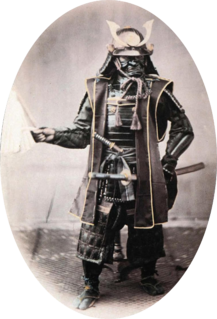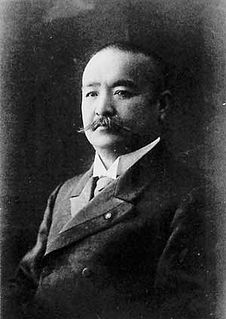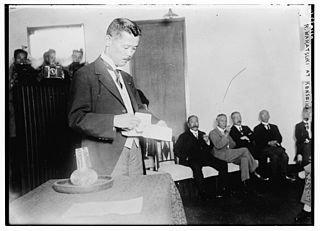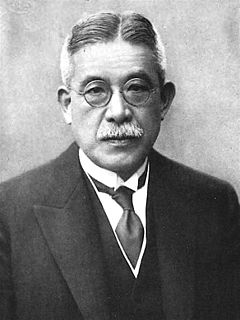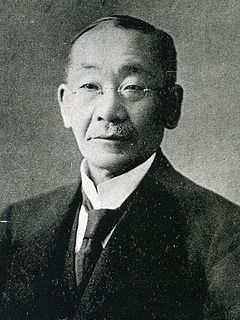Career
Yamamoto's first employment was as a teacher at the Osaka University of Commerce. At 26, he was appointed its principal.
In 1883, Yamamoto turned towards commerce, and obtained a position at the Mitsubishi-affiliated shipping firm Nippon Yusen, in which he rapidly rose through the corporate ranks. In 1890, he joined the Bank of Japan (BOJ), and in 1895 was appointed the chairman of the Yokohama Specie Bank. In April 1896, in order to better acquaint himself with issues pertaining to the gold standard, he travelled to England, and while still in England the following year, was appointed to the board of directors of the Bank of Japan. In October 1898, at the strong request of Bank of Japan governor Iwasaki Yasunosuke, he was recalled to Japan to assume the role of governor of the Bank of Japan. He had been with the Bank of Japan for eight years and was 43 years old at the time.

Nippon Yusen is one of the oldest and largest shipping companies in the world. It is a member of the Mitsubishi keiretsu. The company has its headquarters in Chiyoda, Tokyo, Japan and a fleet of about 800 ships, that includes container ships, tankers, bulk and woodchip carriers, Ro-Ro car carriers, reefer vessels, LNG carrier and cruise ships.

Yokohama Specie Bank was a Japanese bank founded in Yokohama, Japan in the year 1880. Its assets were transferred to The Bank of Tokyo in 1946. The bank played a significant role in Japanese trade with China. The original bank building is now the Kanagawa Prefectural Museum of Cultural History. During the Second World War the bank controversially acted as the paymaster for the Imperial Japanese Army as it conquered parts of Asia.

A gold standard is a monetary system in which the standard economic unit of account is based on a fixed quantity of gold. Three types can be distinguished: specie, bullion, and exchange.
Yamamoto served as BOJ Governor from October 20, 1898, to October 19, 1903. [2] During his tenure, the Japanese economy experienced various crisis pertaining to foreign exchange issues and the gold and silver standards. However, his greatest concern was the increasing budget deficits incurred by the Japanese government. As head of the Bank of Japan, Yamamoto refused to yield to political pressure from the Japanese Diet, the Cabinet, and the genrō to alter his fiscal policies. When political pressure was applied to his subordinates, causing eleven senior managers to resign in protest, Yamamoto used the opportunity to fill the positions with his supporters. Yamamoto’s actions were critical in preserving the future independence of the Bank of Japan from politics. In 1903, the combined efforts of Itō Hirobumi and Yamagata Aritomo managed to dislodge Yamamoto from his position. He was then appointed as a member of the House of Peers, and in 1909 became the head of Nippon Kangyō Ginkō.
The foreign exchange market is a global decentralized or over-the-counter (OTC) market for the trading of currencies. This market determines the foreign exchange rate. It includes all aspects of buying, selling and exchanging currencies at current or determined prices. In terms of trading volume, it is by far the largest market in the world, followed by the Credit market.
The silver standard is a monetary system in which the standard economic unit of account is a fixed weight of silver. The silver specie standard was widespread from the fall of the Byzantine Empire until the 19th century. Following the discovery in the 16th century of large deposits of silver at the Cerro Rico in Potosí, Bolivia, an international silver standard came into existence in conjunction with the Spanish pieces of eight. These silver dollar coins played the role of an international trading currency for nearly four hundred years.
The Cabinet of Japan is the executive branch of the government of Japan. It consists of the Prime Minister, who is appointed by the Emperor after being designated by the National Diet, and up to nineteen other members, called Ministers of State. The Prime Minister is designated by the Diet, and the remaining ministers are appointed and dismissed by the Prime Minister. The Cabinet is collectively responsible to the Diet and must resign if a motion of no confidence is adopted by the Diet.
In 1911, Prime Minister Saionji Kinmochi decided that he needed an expert in the field of finance to reform the Finance Ministry during his second cabinet, and appointed Yamamoto to become Finance Minister. This was the first time that a businessman had been selected to head a cabinet post, and set a precedent for selecting business executives to head ministries focused on economics or finance. [3] However, with a looming financial crisis in the aftermath of the Russo-Japanese War, Yamamoto strongly opposed the Imperial Japanese Army’s demands for additional funding to support an increase in the number of infantry divisions. This issue led directly to the collapse of the Saionji cabinet in 1912. [4] Afterwards, Yamamoto joined the Rikken Seiyūkai political party.

The Prime Minister of Japan is the head of government of Japan. The Prime Minister is appointed by the Emperor of Japan after being designated by the National Diet and must enjoy the confidence of the House of Representatives to remain in office. He is the chairman of the Cabinet and appoints and dismisses the other Ministers of State. The literal translation of the Japanese name for the office is Minister for the Comprehensive Administration of the Cabinet.
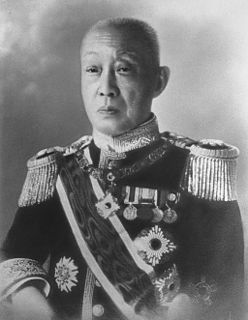
Prince Saionji Kinmochi was a Japanese politician, statesman and twice Prime Minister of Japan. His title does not signify the son of an emperor, but the highest rank of Japanese hereditary nobility; he was elevated from marquis to prince in 1920. As the last surviving genrō, he was Japan's most honored statesman of the 1920s and 1930s.

The Ministry of Finance is one of the cabinet-level ministries of the Japanese government. The ministry was named the Ōkura-shō (大蔵省) until 2001. The Ministry is headed by the Minister of Finance, who is a member of the Cabinet and is typically chosen from members of the Diet by the Prime Minister.
After the start of the Taishō period, during the 1st Yamamoto Gonnohyōe administration, Yamamoto was picked to become Minister of Agriculture and Commerce. Yamamoto also picked another former Bank of Japan governor, Takahashi Korekiyo, to head the Finance Ministry, hoping for a through fiscal revamp of the Japanese government. However, his cabinet was soon brought down by the Siemens scandal. Yamamoto returned again as Minister of Agriculture and Commerce under the subsequent Hara and Takahashi administrations from 1918 to 1922.

The Taishō period, or Taishō era, is a period in the history of Japan dating from 30 July 1912, to 25 December 1926, coinciding with the reign of the Emperor Taishō. The new emperor was a sickly man, which prompted the shift in political power from the old oligarchic group of elder statesmen to the Imperial Diet of Japan and the democratic parties. Thus, the era is considered the time of the liberal movement known as the "Taishō democracy" in Japan; it is usually distinguished from the preceding chaotic Meiji period and the following militaristic-driven first part of the Shōwa period.

Admiral Count Yamamoto Gonbee, GCMG, also called Gonnohyōe, was an admiral in the Imperial Japanese Navy and the 16th and 22nd Prime Minister of Japan.

The Ministry of Agriculture and Commerce was a cabinet-level ministry in the government of the Empire of Japan from 1881-1925. It was briefly recreated as the Ministry of Agriculture and Commerce during World War II
In 1925, Yamamoto joined the new Seiyūhontō party, along with Hatoyama Ichirō; however, the party failed to gain popular support and soon merged with the Kenseikai to form the Rikken Minseitō . However, as a former member of the rival Seiyūkai, Yamamoto found himself excluded from the highest ranks of the party leadership, and passed over for any important positions until 1932, when he was appointed as Home Minister under the Saitō Makoto administration in the aftermath of the March 15 incident. As Home Minister, he presided over a more severe interpretation of the Peace Preservation Laws.
Yamamoto continued to serve in the House of Peers until is dissolution by the post-war Constitution of Japan, and died in 1947 at the age of 91. His grave is at Aoyama Cemetery in Tokyo.






